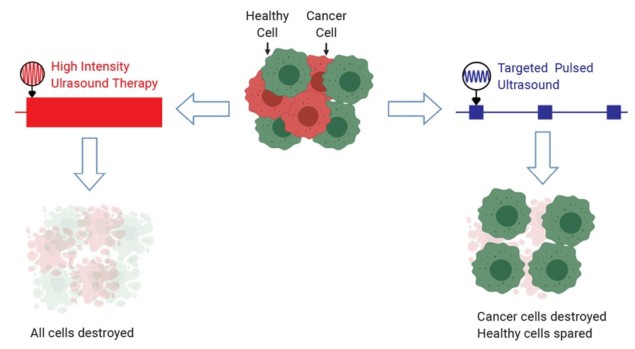Tuned ultrasound selectively disrupts the structure of cancer cells
24 Jan 2020
Medical engineers have proven that the unique internal structure of cancer cells can make them vulnerable to vibrations from specific frequencies of ultrasound. These low-intensity pulsed ultrasound waves are a potentially safe therapy to target cancers of the blood.
High-intensity focused ultrasound is sometimes used to destroy cancer cells deep within tissues, but the thermal energy transmitted can also damage healthy cells at the ultrasound focus. Low-intensity pulsed ultrasound (LIPUS), on the other hand, doesn’t heat up cells but is used to mechanically modulate cells, for stimulating bone repair, for example.
Computational modelling has previously shown that vibrations from LIPUS can selectively kill cancer cells. This led to the oncotripsy theory, which predicts that cells’ response to ultrasound waves depends upon cellular structure – analogous to how a building’s vulnerability to earthquake depends upon its structure. According to this theory, the altered internal structures of rapidly dividing cancer cells makes them vulnerable to certain frequencies of ultrasound. A recent collaboration between researchers at California Institute of Technology and the Beckman Research Institute supports this hypothesis (Appl. Phys. Lett. 10.1063/1.5128627).
“This project shows that ultrasound can be used to target cancer cells based on their mechanical properties,” says lead author David Mittelstein. “It’s an exciting proof-of-concept for a new kind of cancer therapy that doesn’t require the cancer to have unique molecular markers or to be located separately from healthy cells to be targeted.”
Selecting the magnitude
Mittelstein and colleagues tested LIPUS on suspensions of cancer cells (breast, colon or leukaemia) mixed together with healthy immune or red blood cells. They placed these suspensions in acoustically transparent plates, through which they applied short, 60 s, 0.5–0.67 MHz frequencies. Targeted pulsed ultrasound exploits the unique mechanical properties of cancer cells to destroy them. (Courtesy: David Mittelstein)
Targeted pulsed ultrasound exploits the unique mechanical properties of cancer cells to destroy them. (Courtesy: David Mittelstein)
 Targeted pulsed ultrasound exploits the unique mechanical properties of cancer cells to destroy them. (Courtesy: David Mittelstein)
Targeted pulsed ultrasound exploits the unique mechanical properties of cancer cells to destroy them. (Courtesy: David Mittelstein)
The team tested varied ultrasound pulse patterns and found that 0.5 MHz with pulses 20 ms in duration were most effective. Cancer cells’ key structural protein, actin, was immediately disrupted after treatment, leading to almost complete destruction of the cancer cells.
“At certain ultrasound frequencies, low-intensity ultrasound caused the cellular skeleton of cancer cells to breakdown while nearby healthy cells were unscathed,” says Mittelstein.
Under pressure
The team found that acoustic standing waves, formed by a source wave interfering with its reflection, were present in their experiments. These types of waves have a static pattern, with areas of high and low pressure thought to be damaging within a cell. The scientists proved this by using a specially designed cuvette, which eliminated wave reflection and correspondingly cancer cell death.
Next, the researchers measured acoustic transmissions within cells and observed that standing waves rapidly amplified pressure in the cells, causing small cavity formation and collapse. This cavitation process occurred almost in sync with cell cytodisruption, and when cavitation was prevented by conducting experiments within an overpressure chamber, cancer cells survived. Although this proves that standing waves and cavitation were involved in cancer cell death, the scientists also detected cavitation in red blood cells surviving LIPUS.
“We found that standing waves and cavitation are necessary, but not sufficient, for the effect we observed,” Mittelstein explains. “So we suggest that this cell-mediated cavitation may act as a local amplifier of ultrasound. A given cell type’s response to the resulting mechanical stress depends on its biophysical properties.”
Targeted ultrasound in the clinic?
The researchers think that their ultrasound technique can be used to target blood cancer or circulating tumour cells. They also tested LIPUS targeting within solid gels, but this wasn’t as effective at killing the cancer cells. However, Mittelstein hopes that partial cancer cell death within a solid tumour could stimulate the immune system to respond and eliminate any remaining cancer.
“Our next step is to investigate the effect of combined therapy: using the benefits of this safe ultrasound technique to increase the effectiveness of chemotherapy, immunotherapy and other cancer treatments,” said Mittelstein.
FROM PHYSICSWORLD.COM 30/1/2020

Δεν υπάρχουν σχόλια:
Δημοσίευση σχολίου